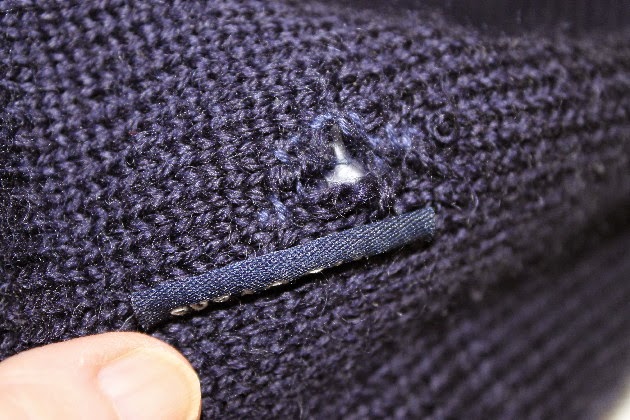There was a time when, in my dim and distant past, I would throw out clothes that had a hole, a missing button or a broken zip. I feel real shame writing those words but it's my shocking truth and made worse by the fact that I knew how to repair all those problems, but I chose not to. I thank my lucky stars that I realised how wasteful I had been and started mending my ways, as well as my clothes.
Last week, one of Hanno's jumpers developed a small hole in the side, right near the side seam. Looks like it was caught on a nail or something. It was a shop bought, pure wool jumper and apart from the hole it was in perfect condition. I got my sewing kit out and started work. The hole was small, about the size of a thumb nail, and as it was at the side seam, it was simply a matter of taking off the messy wool ends and sewing the sides together. Had the hole been any bigger, I would have used my darning mushroom and darned the hole.
This is my darning mushroom.
Darning is a method of sewing that will repair a large hole by using running stitch in and out of the hole. You can use a darning mushroom or egg behind the hole to provide a surface on which to work. Using the remnants of the threads left in the hole, and the edges of the hole, the running stitch from top to bottom and then at right angles, leaves you with a sturdy and clean repair. There are many darning tutorials on You Tube but I like this static tutorial by Wool and Chocolate because of the neat finish she produces.
I used a darning needle for the operation. A darning needle is a steel or plastic needle with a blunt point and an eye large enough to thread through wool or a few strands of embroidery floss. I also needed thread or wool exactly the same colour as the garment I was repairing. I used embroidery floss because I had the exact colour match in thread, but not in wool.
To start off on a small hole repair, turn the garment inside out and carefully cut off any ripped and untidy edges. Anchor your thread or wool by slipping the needle through the knit and tying a knot so the thread is knotted onto the wool. This will give you a firm starting point with no chance of the thread slipping or unravelling later on.
I started the repair job by checking to see if the hole would run a ladder up the side of the jumper, just like a hole in tights would. In this case, yes, if I didn't do something to anchor the ladder, it would have created more problems later on. So working from the wrong side, I stitched the edge of the ladder so it couldn't run, causing a bigger problem. Then it was just a matter of pulling the edges together neatly, with no puckering or folds, to work my way through the hole.
When the hole looked like it was closed, I turned the jumper right side out again to check the repair. This time I didn't have to go back in but sometimes you can see a place where you'll have to go back and add a few more stitches. It's worth doing because this repair took me less than 20 minutes and to work enough hours to buy a similar jumper would take me a few hours.
Have you been repairing clothes too?
Have you been repairing clothes too?






